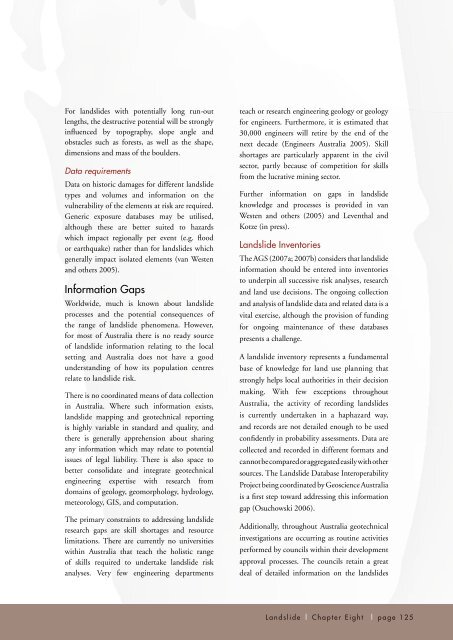Landslide - Geoscience Australia
Landslide - Geoscience Australia
Landslide - Geoscience Australia
Create successful ePaper yourself
Turn your PDF publications into a flip-book with our unique Google optimized e-Paper software.
For landslides with potentially long run-out<br />
lengths, the destructive potential will be strongly<br />
influenced by topography, slope angle and<br />
obstacles such as forests, as well as the shape,<br />
dimensions and mass of the boulders.<br />
Data requirements<br />
Data on historic damages for different landslide<br />
types and volumes and information on the<br />
vulnerability of the elements at risk are required.<br />
Generic exposure databases may be utilised,<br />
although these are better suited to hazards<br />
which impact regionally per event (e.g. flood<br />
or earthquake) rather than for landslides which<br />
generally impact isolated elements (van Westen<br />
and others 2005).<br />
Information Gaps<br />
Worldwide, much is known about landslide<br />
processes and the potential consequences of<br />
the range of landslide phenomena. However,<br />
for most of <strong>Australia</strong> there is no ready source<br />
of landslide information relating to the local<br />
setting and <strong>Australia</strong> does not have a good<br />
understanding of how its population centres<br />
relate to landslide risk.<br />
There is no coordinated means of data collection<br />
in <strong>Australia</strong>. Where such information exists,<br />
landslide mapping and geotechnical reporting<br />
is highly variable in standard and quality, and<br />
there is generally apprehension about sharing<br />
any information which may relate to potential<br />
issues of legal liability. There is also space to<br />
better consolidate and integrate geotechnical<br />
engineering expertise with research from<br />
domains of geology, geomorphology, hydrology,<br />
meteorology, GIS, and computation.<br />
The primary constraints to addressing landslide<br />
research gaps are skill shortages and resource<br />
limitations. There are currently no universities<br />
within <strong>Australia</strong> that teach the holistic range<br />
of skills required to undertake landslide risk<br />
analyses. Very few engineering departments<br />
teach or research engineering geology or geology<br />
for engineers. Furthermore, it is estimated that<br />
30,000 engineers will retire by the end of the<br />
next decade (Engineers <strong>Australia</strong> 2005). Skill<br />
shortages are particularly apparent in the civil<br />
sector, partly because of competition for skills<br />
from the lucrative mining sector.<br />
Further information on gaps in landslide<br />
knowledge and processes is provided in van<br />
Westen and others (2005) and Leventhal and<br />
Kotze (in press).<br />
<strong>Landslide</strong> Inventories<br />
The AGS (2007a; 2007b) considers that landslide<br />
information should be entered into inventories<br />
to underpin all successive risk analyses, research<br />
and land use decisions. The ongoing collection<br />
and analysis of landslide data and related data is a<br />
vital exercise, although the provision of funding<br />
for ongoing maintenance of these databases<br />
presents a challenge.<br />
A landslide inventory represents a fundamental<br />
base of knowledge for land use planning that<br />
strongly helps local authorities in their decision<br />
making. With few exceptions throughout<br />
<strong>Australia</strong>, the activity of recording landslides<br />
is currently undertaken in a haphazard way,<br />
and records are not detailed enough to be used<br />
confidently in probability assessments. Data are<br />
collected and recorded in different formats and<br />
cannot be compared or aggregated easily with other<br />
sources. The <strong>Landslide</strong> Database Interoperability<br />
Project being coordinated by <strong>Geoscience</strong> <strong>Australia</strong><br />
is a first step toward addressing this information<br />
gap (Osuchowski 2006).<br />
Additionally, throughout <strong>Australia</strong> geotechnical<br />
investigations are occurring as routine activities<br />
performed by councils within their development<br />
approval processes. The councils retain a great<br />
deal of detailed information on the landslides<br />
<strong>Landslide</strong> | Chapter Eight | page 125

















